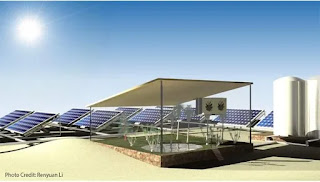Attempts Are Being Made To Grow Crops In The Desert By Storing Water Vapor In Solar Panel Technology
The supply of potable water or electricity has not yet reached many people in the world. Many of those deprived of these facilities live in rural areas. And the climate in many of those areas is quite dry or semi-arid.
Meanwhile, the Middle East is one of the warmest regions in the world. And the scientists in that Middle Eastern country, Saudi Arabia, have created a kind of solar powered technology using a special kind of hydrogel. With the help of this technology, it is possible to produce vegetables successfully by pulling water from the air. Besides, it is also capable of generating electricity. The design came out in a report published on March 1 this year in a journal called ‘Cell Reports Physical Science’. This study can be called a ‘proof-of-concept’. In other words, the theory was already established on how such technology would work. Now scientists have put that theory or method into practice.
According to researchers, this technology could be a sustainable and affordable solution to increase food and water security for people living in arid-climatic zones.
The name of this solar powered system is ‘WEC2P’. The solar panels are mounted on a layer of hydrogel. And all this is placed on a large metal box, so that the steam can be condensed. This is how water is collected from the wind with the help of solar energy.
Researchers have previously studied the hydrogel used in this technology. This special component is able to absorb water vapor from the surrounding air in a very efficient way. This hydrogel is able to release the liquid that has accumulated in it when it is heated again.
Researchers use heat from solar panels to generate electricity. This is done to remove the absorbed water from the hydrogel. The vapor is collected in a metal box at the bottom of the device and the water vapor is condensed into liquid water. On the other hand, this special hydrogel also increases the efficiency of solar panels by about 9 percent. The effectiveness of the panel is enhanced by absorbing heat and lowering the temperature of the panel.
The research team piloted the WEC2P system in Saudi Arabia for two weeks. During the hot summer months of June, they conducted an experiment on tree growth with the help of this system. For this experiment, they irrigated 60 seedlings planted in plastic boxes to grow trees. In this irrigation process, only water collected from the air was used.
These solar panels, about the same size as the top of the student’s desk, generate a total of 1519 watt-hours of electricity during the test. Also in that experiment, out of 60, about 57 calligraphy seeds may germinate and normally they grow up to about 16 cm. In those two weeks it was possible to condense a total of 2 liters of water through hydrogel.
Such technological solutions should be adopted as an alternative method of centralized water and power management to illuminate homes or irrigate crops in the future. This will result in an integrated system of environmentally friendly energy, water and food production.





